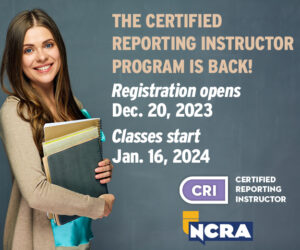My work as a court reporting instructor inspires me to always be on the lookout for ways to reach students, to promote steno skills, to motivate additional practice, to enhance a student’s understanding of how to use steno, and to enlighten a student with a brand new steno brief or bit of advice that helps to propel that student to the next level of steno skill. As I observe students learning to become court reporters, I often compare that process to other activities. After all, we’re learning a skill, and certainly how we learn other skills can be applicable to learning steno.
It was through this observation and research into skill-building and learning that I’ve discovered that the way one learns to play chess – a game that people play for years and years – is very applicable to learning steno. An individual who plays chess at a high enough level of skill that he or she can beat chess experts is known as a chess master. The United States Chess Federation, an organization that oversees chess games and championships, awards titles of National Master, Senior Master, and Life Master. Other chess organizations recognize such titles as Senior International Master and Grandmaster. Players attain these titles based on their performance rating in tournaments and games.
We can compare these titles to the acknowledgement and certification awarded to members of NCRA who achieve stenowriting success. Do you recognize the accomplishments of the RPR as a National Master? The RMR as the Senior Master? Diplomate as the Life Master? And let’s face it, those speed champions we all know, admire, and love are certainly worthy of the title Grandmaster.
Now, I cannot attest to know exactly how the steno masters of our world achieved their success, but I am very sure they practiced a lot and they know their theory rules. They have talent, and they possess perseverance and internal motivation. If you will consider how the game of chess is learned and mastered and then apply those strategies to your quest for skill and knowledge, you will become a steno master sooner than you anticipate.
Let’s consider how we learn generally. Constructivism is a theory of learning that asserts that a person constructs or builds knowledge based on his or her own understanding of the world through experiences and then thinking about and reflecting on those experiences. As we think about things, we change or modify what we thought before, or we may even discard the old information to allow us to construct this new information or knowledge. Learning is a combination of thinking and then remembering.
Consider how someone learns to play chess. It may appear that the game is just about moving pieces around the board. That’s not so different than moving the keys on the steno machine, is it? In both cases, there is a physical element to this skill building. Practice is certainly necessary. After all, you can’t get faster and better if you don’t practice both chess and/or steno, right?
There are specific, reliable rules that apply to playing chess. There are two players who use a 64-square game board. Players take turns playing. One player uses 16 white pieces; the other, 16 black pieces. There are six different kinds of pieces. Each player has one king, one queen, two rooks, two bishops, two knights, and eight pawns. Each piece can be moved only in a particular direction.
There are specific, reliable rules that apply to steno writing. There is one writer, one speaker at a time, one steno machine, a number bar, four vowel keys, and 20 consonant keys. The writer must depress the keys in very particular keystrokes.
That is the first thing about learning to play chess that is valuable to learning to write steno. You must think about the rules. You must know how to write something. You must eventually know how to write everything. Whether you are a new-to-steno student, a middle-of-program student, or an interning student getting ready to look for a job, you must think about steno and stenowriting rules. Think, reflect, and remember; that’s how you learn.
Knowledge of the rules, though, is not sufficient to become a chess or steno master. You must be able to execute the moves. Just as the chess master moves about the chess board, capturing his opponent’s pieces, you need to move about the steno keyboard and capture all the words you hear.
In a chess game, the board is laid out the same way every time. Our steno keyboard never changes. The keys we depress differs dependent on the words, but the keyboard is reliable in its design, just as the chess board is presented reliably each time two people sit down to play.
The player with the white pieces always makes the first move, and then the players take alternating turns. The speaker or dictation always goes first, and the writer responds. We have the same kind of alternative movement as the chess players. We hear words, and then we write them.
The chess pieces move in a predetermined fashion. Our steno outlines have been predetermined. We do have the luxury of creating new outlines for words, but those outlines rely on our rules and the construction of the keyboard.
The goal of chess is for one player to move his or her pieces so that the opposing king is in a position to be captured and cannot escape. The goal of stenowriting is to move the keyboard so that all the words are captured and none have escaped.
There are a variety of strategies that chess players use to help them learn and master the game. A very popular strategy is to control the center of the chessboard. The center of the chessboard is the most active part of the board, and it allows a player the most opportunities to control the remainder of the board. For instance, a knight in the center of a chessboard can cover eight squares; the knight on the edge of the board has only four squares; and the knight in the corner has just two squares available to cover. Players are continually advised to develop their moves so that they will be able to control the center of the board. Losing control of the center of the board typically results in a restricted and cramped game, which leads to a short and failed game.
This particular strategy can be easily adopted by the steno student. Nearly all dictation exercises and tests are five minutes in length. If we consider the center of our dictation minutes two, three, and four, we can approach our practice and test-taking in a new and deliberate fashion that enhances our ability to write and prepare the test transcript.
Begin the first minute knowing you have to concentrate on context and just writing as hard as you can. Push past those first-minute test jitters and settle into the dictation. You can enhance your first minute practice by practicing as many first minutes of different dictation pieces as you can. Set aside a certain amount of your regular practice time each day to work on the first minute of something. This will expand your writing and everyday vocabulary. This will also assist you in getting the feel for a minute of good, solid writing. After writing for a minute, stop and examine your work. Rewrite errors. Consider what is being discussed. Has a question revealed whether this take is a car accident or a divorce or a bankruptcy or a medical case? As you go into the center of that dictation, having gained some control and understanding of the topic, you are better prepared to control the center of the exercise.
It is in the middle that you can make an adjustment to writing if you need, perhaps using a brief. You know what is going on. You are used to the sound of the voices now. You are in a rhythm and writing well. That’s what the middle should be. You can use what you were introduced to in that first minute to help you feel secure and confident.
As you write into that final minute, just hang on. You know by now you are almost done. This is not the time to give up. You are familiar with the content and the speech patterns of the Q&A or the jury charge or the literary take. Trust yourself to finish every last word – and be sure to write the very last word.
Using this technique can boost your transcription of a test. Use every bit of the one hour and fifteen minutes you are allowed. Use what is in the middle of that transcript to help you decipher any untranslated outlines. Look for words that were introduced in the beginning to be used again later. Make sure all names and dates and pronouns are consistent throughout the transcript. Maybe you misunderstood something or have a drop in the first minute, but the correct or missing word is revealed in the middle. Use the whole transcript to help you get the best test transcript possible.
And think! Think about what you are reading as you proofread. Does it make sense? Does it jive with what was in the beginning? Do you have a similar mistroke throughout? Ask yourself what it could be. Say it aloud. Reflect on what you heard. You were learning while you were writing – let that knowledge shine through that transcript.
Chess players assign value points to their chess pieces. Known as the chess piece relative value, it assesses the strength of a piece and helps to determine how valuable a piece is strategically. Standard valuations are typically that the queen is worth nine points, the rook is worth five, the knight and bishop are each worth three points, and the pawn is worth one point. As players make moves throughout a game, they use this point system to help them determine whether it may be worthwhile to move one piece that may be sacrificed as the opponent captures it in order to gain access to or use of another more valuable chess piece.
How can this chess playing strategy influence stenowriting? If writers assign points to particular aspects of their writing, they can then make decisions about how best to progress through an exercise. Using a point system as part of a transcript review practice will reveal how better to approach that exercise the next time. Here is a proposed set of values for the work of the stenowriter.
Pawns are worth only one point. They have the least amount of value in chess. Assign one point to the required or mandatory outlines of your theory. These are typically the homonym outlines or mandatory brief forms. They do ensure accurate translation, but a transcript can be deciphered and produced well through editing and proofreading.
Knights have a value of three points each in chess, indicating they have a greater value than the pawns. Good editing and proofreading skills are essential to our success both as students and professional reporters, and editing should be assigned a value of three points. Sadly, most students have had the unfortunate experience of failing a speed test because of an editing or proofreading error. We always want to avoid that, don’t we?
Bishops, worth three points in chess, are also the pieces that can move as far as possible in a diagonal fashion on the chess board. Bishops work well together in chess because they cover up other pieces’ weaknesses. The asterisk is the keystroke that covers up the steno writer’s weaknesses. The asterisk indicates the writer is aware of context, speed, and theory, so the asterisk gets assigned three points.
Rooks, with their value of five points, are second in value only to the queen. The rook is moved about the chessboard as far as possible forward, backward, and to the sides. While it cannot move diagonally, rooks have a lot of power on the board and are especially powerful because they work well with other rooks in protecting the board and the king. Briefs save time and potential errors. Their use demonstrates a thorough knowledge of the writer’s theory and available brief forms. Briefs can also be created on the fly, advancing the writer’s speed and writing skill. Assign brief forms a point value of five.
The queen is the most valuable piece on the chess board. Accurate writing is the most important tool the stenowriter has. Whether writing with a lot of brief forms or not, accurate keystrokes are necessary for realtime writing. Do not ignore the fact that any writer’s dictionary is truly infinite in size, and an unlimited number of entries can be incorporated into a dictionary. Taking misstrokes – WEPBLT for WEPBT (went), for example – and turning them into outlines, in essence, makes an otherwise inaccurate writer an accurate writer. Accuracy is developed through countless hours of practice of good stroking technique, review of transcribed words against dictation, and maintenance of one’s dictionary. Writers who track their rate of accuracy in practice will very often find that they have that same level of accuracy on a test. Accuracy is our most important steno tool at any time and should be awarded nine points.
How can we use this point system as a strategy for building skills? First, develop a plan for evaluating practice performance. You should use a chart or Excel spreadsheet to help you with this process. Create a table that includes a place to list your word-per-minute attempt, brief forms, and mandatory outlines. Add words and outlines to this document as you review your work.
Assign each word of the exercise nine points. This gives us a very large total for any exercise. A 140 word-per-minute exercise has 700 words. Assigning each word a value of nine points, the exercise is worth 6,300 points. From that total accuracy point value, we are going to first subtract all of the mistroked, miswritten, and dropped words. This requires the writer to complete a writing exercise and then review the transcript against the dictation and with a keen eye on how the words and keystrokes were executed. If you dropped, mistroked, or miswrote 100 words in your 700-word exercise, you must now subtract 900 points from that total of 6,300. (Nine points per word, 9 x 100 = 900). You now have 5,400 points for your exercise.
Next, examine your work to determine how well you used your other writing tools. Review your steno and your transcript. If you had an error because you did not use a mandatory stroke correctly, subtract that from your current total. If, on the other hand, you used your mandatory strokes, add points for each of those words.
Look for your use of the asterisk. Did you use the asterisk? Lots of times, students will rewrite a mistroked word without using the asterisk, thinking that they will realize what they did or they just didn’t strike the asterisk in time. If you have a place where you should have used the asterisk but did not, subtract three points each time. If you did use an asterisk to make a correction, add three points.
Search your steno for brief forms. Did you use as many as you could? For each brief form that you know, but did not execute, subtract five points. For each brief form you did use correctly, add five points.
After completing this thorough review of your work, determine how many points you have accumulated. Your point goal is to have at least nine points per word or more. You get more points by giving yourself credit for using brief forms, mandatory outlines, the asterisk, and so on.
If you are reviewing a transcript after a teacher’s assessment, examine it especially for any proofreading or editing errors. Keep track of those so that you can study them and avoid them in the future. Know where you utilized punctuation and word usage correctly so that you can reflect on that and repeat that in the future. As you review practice, award editing points for correct application of punctuation and deduct points for a lack of correct punctuation. The more you apply these editing features in your writing, the more you are enhancing your learning of these skills.
Before rewriting the exercise for further practice, modify your dictionary in any way you can to improve your translation on further writing of those words. Write the brief forms and phrases you used for reinforcement and the ones you know you should have used. Think about the theory rules that apply to everything you have written. Learn something from what you wrote. Think about the context. Be sure that you understand every word that was said and what the intent of the dialogue was. Construct some knowledge. Keep practicing until you have won the game. Work in small segments of the dictation, and apply the point system to that passage. Continually ask yourself if you have written that part in the best possible, most efficient, theory-based, stroke-minimizing way. If the answer is yes, then you just need to do it again and again until it is natural. Your writing skills will improve, and you will have enduring power to keep writing well.
Approaching a steno writing exercise like a chess game allows you to take on your opponent, the dictation, with a plan of attack and a strategy to win. Thinking about what you are doing and remembering how to do it builds knowledge that, in turn, allows you to build the skill to execute game-winning strokes.
There are three more keys to successful writing that we share with successful chess players.
Chess masters play a lot. They thing about their moves, they reflect on what they did that worked well, and they know which moves put them into a place to lose the game. Steno masters practice a lot. Steno masters write a lot, and they reflect on what they wrote – what was well written and what lacked accuracy and efficiency. The more you practice, the better you will be.
Chess masters study the game. There are lots of book available on chess, but steno writers don’t have to go anywhere to find a way to study. Review old theory lessons. Review a section of your dictionary. Pick up any book or newspaper or magazine and look at those English words and think about the steno rules that apply to their correlated keystrokes.
Chess masters have fun. They don’t give up when they don’t win all the time. World chess champions have lost plenty of games. They just keep going. They recognize their successes, and they play with the intent to have fun. Steno writers should have fun as well. Slow down the dictation if you need to so that you experience success. Increase the speed incrementally, moving up only when you know that your most recent speed was written with precision.
Approach your steno skill-building as if you were playing chess. Develop a desire to be a steno master. Build skill and knowledge each time you write. Review your work thoroughly and carefully, determining what aspect of your steno skills needs attention at any particular time. Soon, you will be saying “checkmate” as you turn in your test transcript, knowing you were the champion of that round. From there, it is only a matter of time until you are sitting on a stage, competing for the title of World’s Fastest Court Reporter and being recognized as a steno grandmaster.
Jen Krueger, RMR, CRI, CPE, is a freelance court reporter and a court reporting instructor. She can be reached at jen.krueger@tri-c.edu








